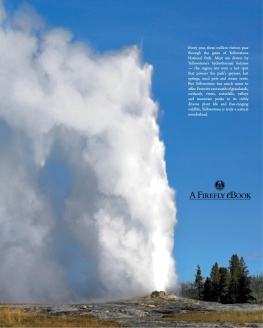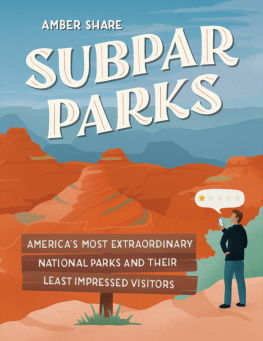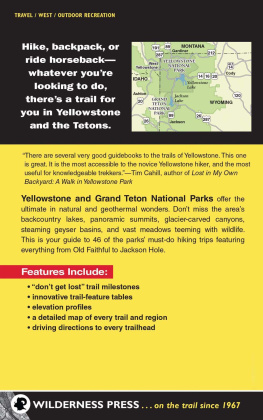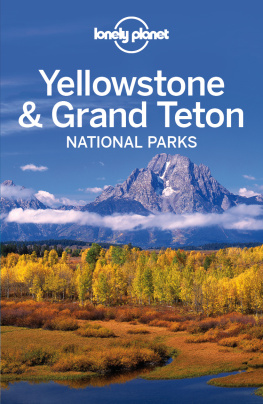Print edition published by Firefly Books Ltd. 2011
Text copyright 2011 Firefly Books Ltd.
eBook copyright 2014
Photographs copyright 2011 Tim Fitzharris
All rights reserved. No part of this publication may be reproduced, stored in a retrieval system, or transmitted in any form or by any means, electronic, mechanical, photocopying, recording or otherwise, without the prior written permission of the Publisher.
Published in Canada by Firefly Books Ltd.
50 Staples Avenue, Unit 1
Richmond Hill, Ontario L4B 0A7
The Publisher gratefully acknowledges the financial support for our publishing program by the Government of Canada through the Canada Book Fund as administered by the Department of Canadian Heritage.
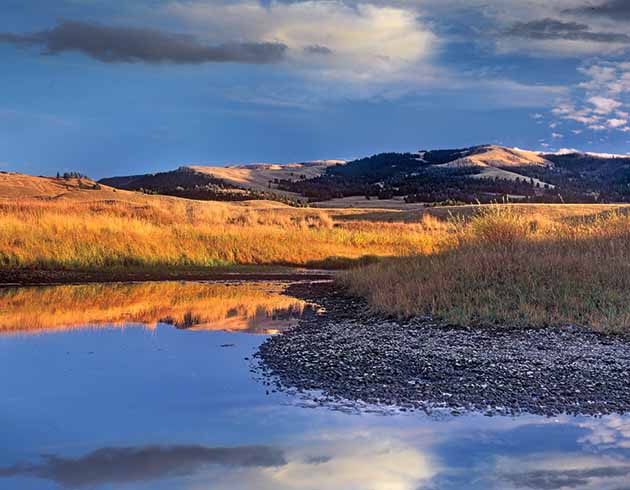
Slough Creek, above, eventually joins up with the Yellowstone River.
Yellowstone
An Introduction
On March 1, 1872, the U.S. Congress changed the course of American environmental and recreational history when it passed a bill to establish Yellowstone National Park. This resounding support for the preservation of a wilderness area made official what anyone who had visited the region already knew: Here was a vast piece of land so spectacular and so rare that it demanded special consideration and protection.
The inaugural park in the countrys National Park System, Yellowstone continues to hold a distinct place in the hearts and imaginations of people all over the world. A thousand Yellowstone wonders are calling, Look up and down and round about you! wrote John Muir, a wilderness-preservation advocate and the founder of the Sierra Club, in 1909. In the early years of the 21st century, American travel writer Tim Cahill echoed the sentiment, affectionately describing Yellowstone as an embarrassment of wonders.
These two claims, made almost a century apart, can be supported by numbers alone. Yellowstone encompasses 2.2 million acres, the majority of which lies within the state of Wyoming, with its western and northern borders dipping into Idaho and Montana. Scattered across the park are half of the worlds total active thermal features geysers, hot springs, mud pots, steam vents and terraces some 10,000 in all. Its more than 300 geysers represent two-thirds of the Earths entire geyser catalog. Each feature is animated by groundwater that has been superheated by molten magma rising from the Yellowstone hot spot. Scientists claim that this hot spot is a mere three to eight miles beneath the Earths crust.
As if its dazzling array of waterworks were not enough, Yellowstone is also home to a showcase of other marvels. Almost 700 miles in length, the Yellowstone River is the longest undammed river in the lower 48 states. It flows tranquilly through the Hayden Valley before it is transformed into a frothing waterway that roars over two sizable waterfalls and surges along a 20-mile canyon steeply banked by multicolored 1,000-foot cliffs.
More than 40 mountain peaks in the Yellowstone area reach heights greater than 10,000 feet. Subalpine forests color the mountain ranges that ring the park as well as the mountain slopes within the parks boundaries, while the stunted stumps of petrified trees in the Lamar Valley are evidence of a forest that covered the region 55 million years ago.
Hundreds of rivers and creeks wind through lush valleys, serving as a favored grazing ground for wildlife. In the mountains, the rivers are studded with an astounding 290 waterfalls, many of them so remote that they are rarely seen by park visitors. At just over 130 square miles, Yellowstone Lake is the largest freshwater lake in the park and the largest mountain lake in North America. It is 410 feet deep in places and is covered in a layer of ice two feet thick during the parks long, brutal winters. At the same time, the water temperature at the bottom of the lake is near boiling in some areas.
Sweeping plains, wildflower meadows and flatlands characterize much of the central parkland, which provides habitat to an abundance of wildlife. Roughly 70 species of mammals, 320 bird species and assorted native fish, reptiles and amphibians make their home in Yellowstone. The ancestors of some of these animals roamed the same land thousands of years ago.
Wildfires are also an important part of the ecosystem. Most often ignited when lightning strikes the summer-dry tinder of old-growth forests and fed by a desiccated understory of needles and branches, Yellowstones infamous infernos tear through the region, demolishing everything before them, yet leaving in their wake the adaptive seeds of future trees, ready to sprout in the fire-blackened earth.
There is no way of knowing just what its first inhabitants made of Yellowstones living, breathing landscape. After the last glacial ice retreated over 13,000 years ago, Paleo-Indians of the Clovis culture hunted mastodons and mammoths here. In more modern times, Yellowstone was settled by members of the Shoshone Nation, but others such as Crow and Kiowa lived here as well.
By the early 19th century, as European-Americans began to take a more aggressive interest in the opportunities of their newly settled continent, white men arrived to explore the region. John Colter was one. In 180708, after wintering in Yellowstone and investigating the Yellowstone River and its Grand Canyon and Upper and Lower falls, Colter returned to civilization and shared impressions so seemingly outlandish that nobody believed him. Mountain man Jim Bridger followed 20 years later, adding outright lies to the lore that left the public even more uncertain about the truth concerning this simmering, bubbling, exploding terrain.
A succession of expeditions to Yellowstone followed, including that of prospectors Charles Cook, David Folsom and William Peterson in 1869, and the Washburn Yellowstone Expedition of 1870, led by Henry Washburn, the Surveyor General of Montana Territory, army escort Lieutenant Gustavus C. Doane and the man who would later be named the parks first superintendent, Nathaniel Pitt Langford. Even Langfords reports were received with skepticism. In a review of an article hed published about the trip, he was accused of being the champion liar of the Northwest, though in response, a member of the U.S. Geological Survey insisted that Langford did not dare tell one-half of what he saw.
Geologist Ferdinand V. Haydens expedition followed in 1871. Thanks to Haydens technical assessment and the contributions of frontier photographer William Henry Jackson and landscape painter Thomas Moran, Haydens group returned with the hard factual and visual evidence that at last dispelled the publics long-standing doubts about Yellowstone.
Indeed, it was Hayden who climbed 10,243-foot Mount Washburn and, gazing south over the landscape, realized that he was looking down at one vast crater made up of thousands of smaller volcanic vents and fissures out of which the fluid interior of the earth, fragments of rocks and volcanic dusts were poured in unlimited quantities.
Hayden was describing the Yellowstone caldera, a volcanic crater formed during three monumental eruptions, the first of which occurred after the continent drifted over the Yellowstone hot spot roughly two million years ago. The second took place 1.3 million years ago, while the third shaped Yellowstones modern landscape 640,000 years ago. These eruptions, and many more minor ones, threw up mountain ranges and produced lava flows that left a tough rocky layer over much of todays park. After the molten rock, massive sheets of glacial ice, buried most of the Yellowstone region. Over thousands of years the glaciers compressed, sculpted and smoothed the lakes, rivers and mountains of todays Yellowstone National Park, leaving behind much of the soil in which its plants and forests thrive as well as the countless cracks, creases and channels in the Earths surface that help define the park.
Next page
